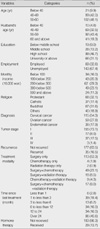Abstract
Purpose
This study was done to identify psychosocial factors that might be predictive of sexual desire, arousal, lubrication, orgasm, satisfaction, and pain in women with gynecologic cancer.
Methods
Two hundred and twelve women with cervical, ovarian, or endometrial cancer completed questionnaires on the Female Sexual Function Index including sexual desire, arousal, lubrication, orgasm, satisfaction, and pain, and data on their psychosocial factors including body image, sexual attitude, sexual information, depression, and marital intimacy. Stepwise multivariable regression analysis was performed to explore psychosocial predictors of women's sexual function domains.
Results
Predictors were identified as sexual attitude, depression, sexual information, and body image for sexual desire; sexual information, depression, and sexual attitude for sexual arousal; sexual information, marital intimacy, and depression for lubrication; sexual information, marital intimacy, depression, and body image for orgasm; marital intimacy, sexual information, sexual attitude, and depression for satisfaction; sexual information, depression, and marital intimacy for pain.
Conclusion
The results indicate that women's sexual function needs to be approached to domains of female sexual function psychosocially as well as to general sexual function. These factors should be considered in future interventions to positively promote sexual function in women with gynecologic cancer.
Figures and Tables
References
1. Bancroft J, Loftus J, Long JS. Distress about sex; A national survey of women in heterosexual relationship. Archives of Sexual Behavior. 2003. 32:193–208.
2. Basson R, Berman J, Burnett A, Derogatis L, Ferguson D, Fourcroy J, et al. Report of the international consensus development conference on female sexual dysfunction: Definition and classifications. Journal of Urology. 2000. 163:888–893.
3. Carmack Taylor CL, Basen-Engquist K, Shinn EH, Bodurka DC. Predictors of sexual functioning in ovarian cancer patients. Journal of Clinical Oncology. 2004. 22:881–889.
4. Chang SB. An analytic study on influencing factors for sexual satisfaction in women who have had a hysterectomy. Journal of Korean Academy of Nursing. 1989. 19:160–172.
5. Chon KK, Rhee MK. Preliminary development of Korean version of CES-D. Korean Journal of Clinical Psychology. 1992. 11:65–76.
6. Chun N. Structural equation modeling on sexual function in women with gynecologic cancer. 2007. Seoul: Seoul National University;Unpublished doctoral dissertation.
7. Chun N. A structural equation model on sexual function in women with gynecologic cancer. Journal of Korean Academy of Nursing. 2008. 38:639–648.
8. Chun N, Park YS. Sexual function in women with gynecologic cancer. Korean Journal of Women Health Nursing. 2006. 12:308–315.
9. Derogatis LR, Meyer JK, Vazquez F. A psychological profile of the transsexual. I. The male. Journal of Nervous and Mental Disease. 1978. 166:234–254.
10. Doo JK. Sexual dysfunction in women. Korean Society of Obstetrics and Gynecology. Continuing Education. 2000. 30:80–90.
11. Jensen PT, Groenvold M, Klee MC, Thranov I, Petersen MA, Machin D. Early-stage cervical carcinoma, radical hysterectomy, and sexual function. A longitudinal study. Cancer. 2003. 100:97–106.
12. Kadri N, McHichi Alami KH, McHakra Tahiri S. Sexual dysfunction in women: Population based epidemiological study. Archives of Women's Mental Health. 2002. 5:59–63.
13. Kim JK, Koh HJ, Lim KH. A study on sexual knowledge, attitude and activity according to sexual satisfaction of wife and husband after hysterectomy. Journal of the Korean Society of Maternal and Child Health. 2002. 6:71–82.
14. Kim SN. A structural model for quality of life in women having hysterectomies. Journal of Korean Academy of Nursing. 1999. 29:161–173.
15. Laumann EO, Paik A, Rosen RC. Sexual dysfunction in the United States: Prevalence and predictors. Journal of American Medical Association. 1999. 281:537–544.
16. Malacara JM, Canto de Cetina T, Bassol S, Gonzalez N, Cacique L, Vera-Ramirez ML. Symptoms at pre- and postmenopause in rural and urban women from three states of Mexico. Maturitas. 2002. 43:11–19.
17. Nappi RE, Verde JB, Polatti F, Genazzani AR, Zara C. Self-reported sexual symptoms in women attending menopauseclinics. Gynecologic and Obstetric Investigation. 2002. 53:181–187.
18. Polit DF, Beck CT. Nursing research -principles and methods. 2004. 7th ed. Philadelphia, PA: Lippincott Williams & Wilkins.
19. Radloff LS. The CES-D scale: A self-report depression scale for research in the general population. Applied Psychological Measurement. 1977. 1:385–401.
20. Rodes JC, Kjerulff KH, Lengenberg PW, Guzinski GM. Hysterectomy and sexual functioning. Journal of American Medical Association. 1999. 282:1934–1941.
21. Rosen R, Brown C, Heiman J, Leiblum S, Meston C, Shabsigh R, et al. The female sexual function index (FSFI): A multidimensional self-report instrument for the assessment of female sexual function. Journal of Sex & Marital Therapy. 2000. 26:191–208.
22. Shokrollahi P, Mirmohamadi M, Mehrabi F, Babaei G. Prevalence of sexual dysfunction in women seeking services at family planning center in Tehran. Journal of Sex & Marital Therapy. 1999. 25:211–215.
23. Simon W, Gagnon JH. Sexual scripts: Permanence and change. Archives of Sexual Behavior. 1986. 15:97–120.
24. Speer JJ, Hillenberg B, Sugrue DP, Blacker C, Kresge CL, Decker VB, et al. Study of sexual functioning determinants in breast cancer survivors. Breast Journal. 2005. 11:440–447.
25. Stewart DE, Wong F, Duff S, Melancon CH, Cheung AM. "What doesn't kill you makes you stronger": Anovarian cancer survivor survey. Gynecologic Oncology. 2001. 83:537–542.
26. Waring EM, Reddon JR. The measurement of intimacy in marriage: The Waring intimacy questionnaire. Journal of Clinical Psychology. 1983. 39:53–57.
27. West LW, Vinikoor LC, Zolnoun DA. Systemic review of the literature on female sexual dysfunction prevalence and predictors. Annual Review of Sex Research. 2004. 15:40–172.
28. Wiegel M, Meston C, Rosen R. The female sexual function index (FSFI): Cross-validation and development of clinical cutoff scores. Journal of Sex and Marital Therapy. 2005. 31:1–20.
29. World Health Organization. Defining sexual health, Report of technical consultation on sexual health. 28-31. January 2002, Geneva. 2006.
30. Yu HS. Predictors of female sexual dysfunction. 2003. Seoul: Seoul National University;Unpublished master's thesis.




 PDF
PDF ePub
ePub Citation
Citation Print
Print






 XML Download
XML Download